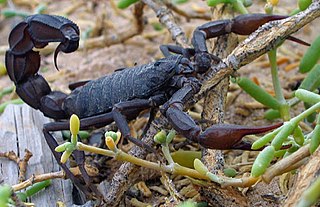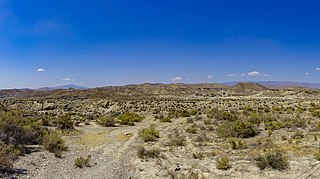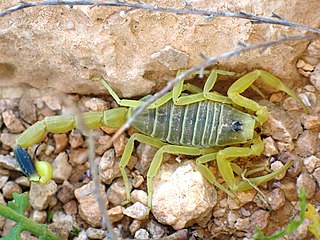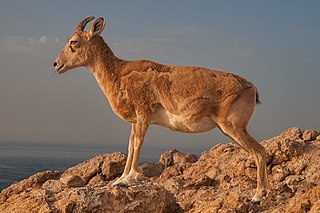
Scorpions are predatory arachnids of the order Scorpiones. They have eight legs, and are easily recognized by a pair of grasping pincers and a narrow, segmented tail, often carried in a characteristic forward curve over the back and always ending with a stinger. The evolutionary history of scorpions goes back 435 million years. They mainly live in deserts but have adapted to a wide range of environmental conditions, and can be found on all continents except Antarctica. There are over 2,500 described species, with 22 extant (living) families recognized to date. Their taxonomy is being revised to account for 21st-century genomic studies.

Oryx is a genus consisting of four large antelope species called oryxes. Three of them are native to arid parts of Africa, and the fourth to the Arabian Peninsula. Their fur is pale with contrasting dark markings in the face and on the legs, and their long horns are almost straight. The exception is the scimitar oryx, which lacks dark markings on the legs, only has faint dark markings on the head, has an ochre neck, and horns that are clearly decurved.

Fattail scorpion or fat-tailed scorpion is the common name given to scorpions of the genus Androctonus, one of the most dangerous groups of scorpions species in the world. They are found throughout the semi-arid and arid regions of the Middle East and Africa. They are a moderate sized scorpion, attaining lengths of 10 cm. Their common name is derived from their distinctly fat metasoma, or tail, while the Latin name originates from Greek and means "man killer". Their venom contains powerful neurotoxins and is especially potent. Stings from Androctonus species are known to cause several human deaths each year. Several pharmaceutical companies manufacture an antivenom for treatment of Androctonus envenomations.

Parabuthus transvaalicus is a species of venomous scorpion from semi-arid parts of southern Africa.
Kurtoxin is a toxin found in the venom of the scorpion Parabuthus transvaalicus. It affects the gating of voltage-gated sodium channels and calcium channels.

The desert long-eared bat is a species of vesper bat found in North Africa and the Middle East.

The Pharaoh eagle-owl is a species of owl in the family Strigidae. It is found in Algeria, Chad, Egypt, Eritrea, Iran, Iraq, Israel, Jordan, Kuwait, Libya, Mali, Mauritania, Morocco, Niger, Oman, Palestine, Qatar, Saudi Arabia, Senegal, Sudan, Tunisia and the United Arab Emirates.

The Buthidae are the largest family of scorpions, containing about 80 genera and over 800 species as of mid-2008. Its members are known as, for example, fat-tailed scorpions and bark scorpions. A few very large genera are known, but a high number of species-poor or monotypic ones also exist. New taxa are being described at a rate of several to several dozen new species per year. They occur in the warmer parts of every major landmass on Earth, except on New Zealand. Together with four other families the Buthidae make up the superfamily Buthoidea. The family was established by Carl Ludwig Koch in 1837.

The Tabernas Desert is one of Spain's semi-arid deserts, located within Spain's southeastern province of Almería. The desert is located in the interior, about 30 kilometers (19 mi) north of the provincial capital, Almería, in the Tabernas municipality. Due to its high altitude and inland location, it has slightly higher annual rainfall and lower annual average temperature than coastal areas of Almeria. It is a nature reserve spanning 280 square kilometres.
Buthacus is a genus of scorpion of the family Buthidae. It is distributed across northern and western Africa, Israel, Palestine, Jordan, Syria, the Arabian Peninsula, Iraq, Iran, Afghanistan, and Pakistan.

Leiurus is a genus of scorpion of the family Buthidae. The most common species, L. quinquestriatus, is also known under the common name Deathstalker. It is distributed widely across North Africa and the Middle East, including the western and southern Arabian Peninsula and southeastern Turkey. At least one species occurs in West Africa.
Altitoxin is a neurotoxin found in the South African scorpion Parabuthus transvaalicus. Injection of altitoxin in mice leads to akinesia, depression and death.
Ikitoxin is a neurotoxin from the venom of the South African Spitting scorpion that targets voltage-sensitive sodium channels. It causes unprovoked jumps in mice following intracerebroventricular injections.

Androctonus crassicauda, the Arabian fat-tailed scorpion, is a species of dangerous scorpion usually found in North Africa and the Middle East.

Androctonus bicolor, the black fat-tailed scorpion, is a scorpion species of the family Buthidae. It is black in color and can grow up to 9 cm.

The black hairy thick-tailed scorpion, Parabuthus villosus, is a species of scorpion from southern Africa, where it ranges from the Northern Cape to Namibia. It is the largest species of the Buthidae, measuring up to 18 cm, and its diet may include lizards and mice. The species is often active at dawn and dusk, but takes refuge by day in a variety of shelters. It resembles Parabuthus transvaalicus, which is more strictly nocturnal, less hairy and with a more easterly distribution.

Parabuthus is a genus of large and highly venomous Afrotropical scorpions, that show a preference for areas of low rainfall. Their stings are medically important and human fatalities have been recorded.

Qatar is a peninsula on the Northeastern coast of the Arabian Peninsula bordering Saudi Arabia to the south and surrounded elsewhere by the Persian Gulf. A strait separates Qatar from the island kingdom of Bahrain.

Parabuthus granulatus, commonly known as the granulated thick-tailed scorpion, a large species of scorpion from the drier parts of southern Africa. It measures some 11.5 cm, and is dark yellow to brown in colour. It has a relatively small vesicle, but is one of the more venomous scorpion species of the region. Of all scorpion species, it causes most of the serious cases of envenomation in South Africa, and a few people die each year from their sting.

The wildlife of Kuwait consists of the flora and fauna of Kuwait and their natural habitats. Kuwait is a small country in the Middle East at the head of the Persian Gulf, located between Iraq and Saudi Arabia, and the land surface consists mainly of desert.














